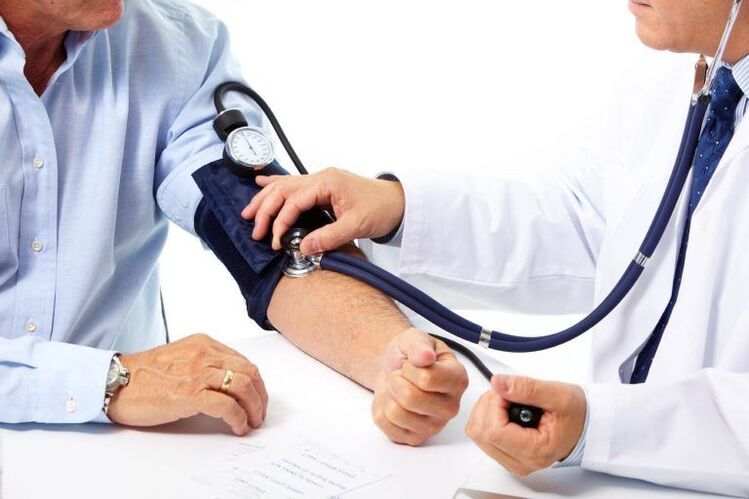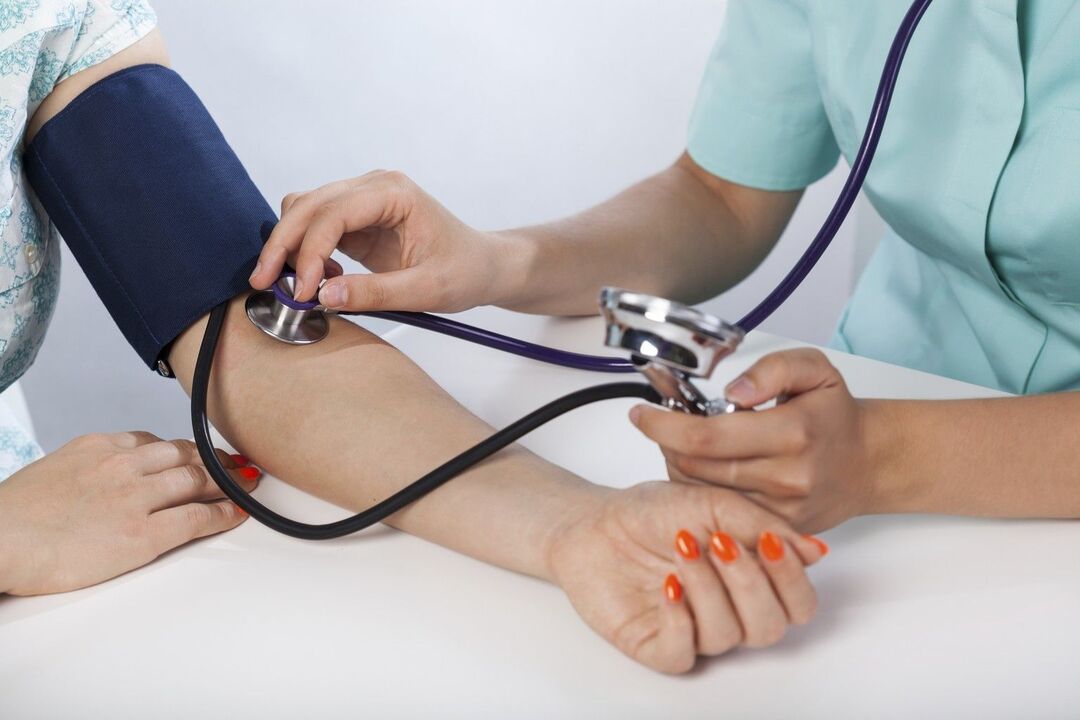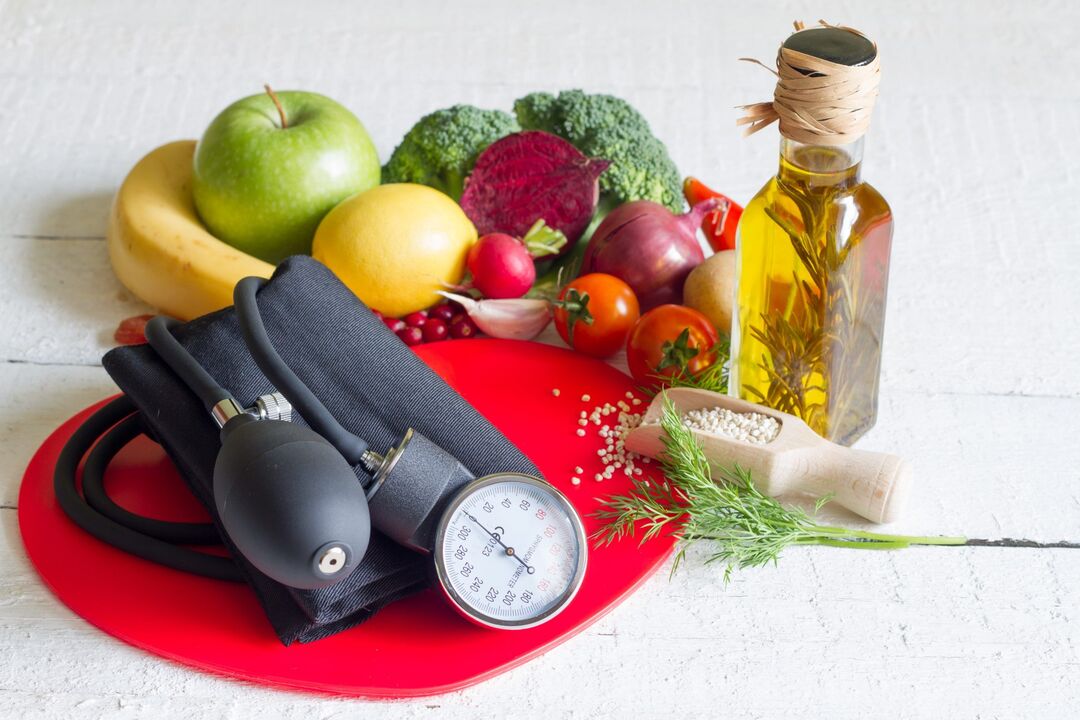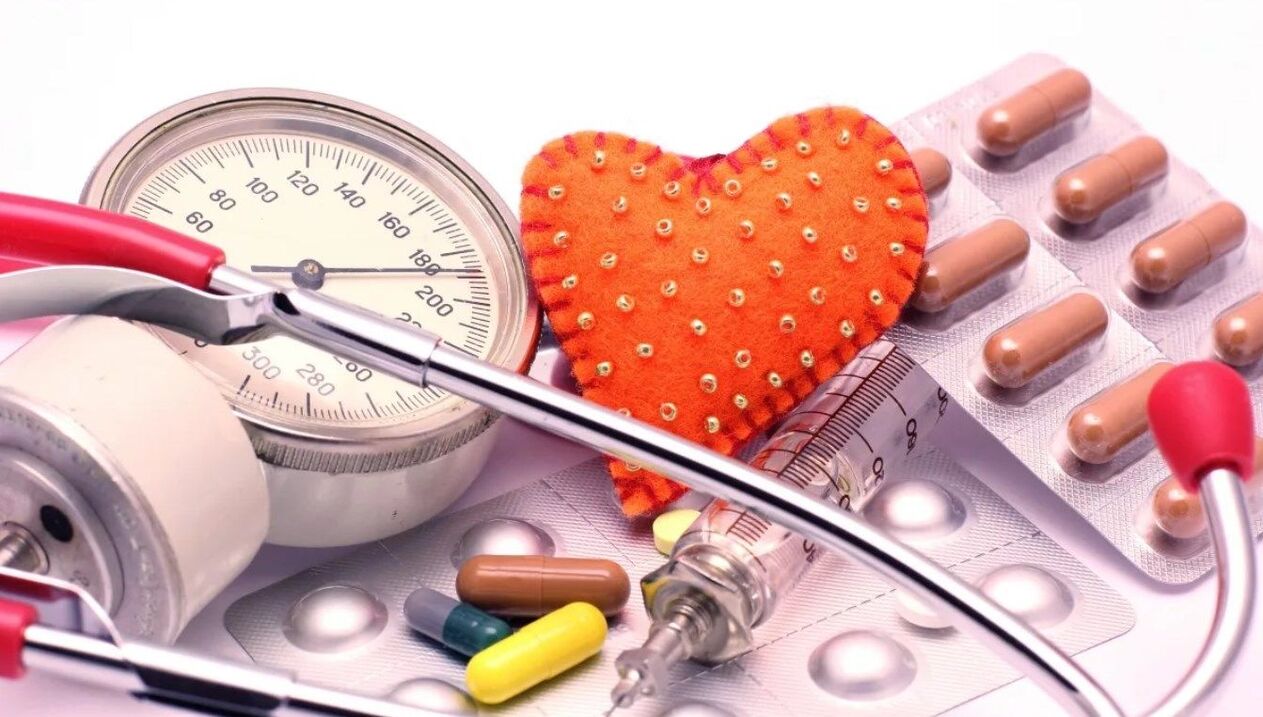
Hypertonic disease is the most common disease of the circulating system around the world. About 30% of the world's population suffers from this disease. In recent years, significant "rejuvenation" diseases was observed - among the sick, more and more young, middle ages.
Hypertension is full of heavy, disabled complications, often leads to death. At the same time, it is subject to a series of rules, phenomena and disease development can be delayed by years. Each person should be familiar with risk factors for the development of hypertension, its symptoms and the principles of treatment.

What is hypertension
Hypertonic disease or arterial hypertension (synonym: essential hypertension, primary hypertension) - prone to progress, in the clinical picture, whose leading symptoms (I. E. , arterial hypertension syndrome).
The criteria for arterial hypertension are considered systolic blood pressure (blood pressure) from above or equal to 140 mm Hg. Art. and / or diastolic blood pressure greater than 90 mm Hg. Art.
Etiology of the disease
Hypertonic disease is considered an idiopathic disease, the immediate causes of its phenomenon are not established.
Among the numerous theories of the appearance and development of primary hypertension, the classic neurogenic theory is the widespread. This concept welcomes hypertension as a neurotic state of greater nervous activity. The initial mechanism is considered nervous surge (acute or extended, chronic), which causes brain structures that are responsible for regulating blood pressure. Of particular importance are emotions that have not received implementation in a motor-sphere, such - the correlated emotions ".
In the appearance of primary hypertension, genetic predisposition is monitored. In 35-50% of people suffering from hypertension, the family nature of the disease is noticed. A specific gene, the lack would lead to a persistent increase in blood pressure, was not detected. Probably, the disease has a polygenic type of inheritance.
Patogenesis hypertension
The pathogenesis of primary hypertension is complicated and has its own characteristics at different stages. According to neurogenic theory, under the influence of nervous surge, the inhibitory effect of the cortex of large brain hemisphere is reduced on subscortic (hypotalamic) vegetative centers, which causes the sympathetic pressure system (vasonstrictor). There is an adrenaline broadcast, the ejection of the heart, the artery narrowed (including renal), increases, increases blood pressure. The spasm of the kidney arteries activates another powerful press-renin-angiotenzin-aldosteron, which makes a significant contribution to increasing blood pressure. Other vasoconstrictive agents are also connected and over time - antidiuretic hormone, prostacilla, endotel, tromboxan. They oppose depression systems-vascular prostaglandin, kallikrein-kinin and sodium-reuters system. The debt cramping of the artery leads to a violation of the function of their inner shell (endothelia), the restructuring of the walls of blood vessels and contributes to the development of atherosclerosis.
Risk factors
Risk factors are attributed to signs, whose presence on people increases the likelihood of disease development. The diversity of risk factors for primary hypertension is divided into two groups - modified and unmodified.
Unmodified risk factors (impossible to influence them)
They include:
- Male sex is among the men of younger, medium incidences of hypertension higher than in women at the same age. Low incidence in women is explained by the protective effect of estrogen. The prevalence of hypertension in representatives of both sexes older than 60 years is approximately the same;
- Age (more than 50-60 years) - The prevalence of hypertension increases abruptly in age;
- Heredity - The presence of cases of essential hypertension in the family increases the risk of illness.
Changed risk factors (subject to influence)
They include:
- Smoking - Nicotine has a strong vasoconstrictor effect. Active and passive smoking lead to blood vessel cramps, increased blood pressure;
- Obesity - I. E. body weight index is above 30 kg / m2. Clinical studies prove that the frequency of hypertension increases as human weight is growing. Defendant of subcutaneous fat in the area of the waist (abdominal obesity) is especially dangerous, because it is associated with extremely high risk primary hypertension. This is due to the stimulation of the sympathetic adrenal system in fat people. Waist Waist Over 80 cm for women and more than 94 cm for men is a serious risk factor for hypertension;
- Sedentary lifestyle (hypodynamy) - Insufficient physical activity causes the development of obesity;
- Surplus receipt of salt salts with food products (over 5 g per day);
- Excessive drink (over 30g ethyl alcohol per day);
- Unbalanced diet (high-calories, with excess saturated fats) - causes obesity;
- Stressful situations.
Classification of arterial hypertension
Primary hypertension is classified according to the level of arterial hypertension, the nature of the lesion of target bodies.
Classification of the level of arterial hypertension (AG)
Category systolic blood pressure, mm Hg. Art. Diastolic blood pressure, mm Hg. Art.
- Arterial hypertension and degrees 140-159 90-99
- Arterial hypertension II degree 160-179 100-109
- Arterial hypertension III degree ≥180 ≥110
Classification of nature defeat target authorities
Mishenian organs are called these bodies in which the pathological changes are clarified primarily due to hypertension. For primary hypertension, goals are the heart, kidneys, brain, mesh shells of the eye, blood vessels.
3 phases of primary hypertension
It is common to distinguish 3 phases of primary hypertension:
Phase and-Carterized due to the lack of changes in targeted organ;
Phase II- There are changes in the target bodies that are not manifested by no symptoms:
- heart: Increasing the left ventricle (according to the results of the ECG or heart ultrasound);
- Vessels:Signs of thickening of the walls, the presence of plaque (according to the results of ultrasound, angiography);
- Kidneys:Reduction of function, microalbuminuria (detection of small parts of protein in urine);
- Retina: narrowing, impregnation of blood vessels;
Phase III- There are symptoms of changes in targeted organs:
- heart: ischemic disease, heart failure;
- brain: passing disorders of cerebral blood flow, stroke;
- Kidneys:Kidney stop;
- Vessel: an occlusion of peripheral blood vessels, which delayed aneurism aortic;
- Retter eye:Edem, bleeding, excreted.

Symptoms of hypertension
In some cases, for a long time, the only symptom of essential hypertension remains increasing blood pressure. It can be accompanied by unnecessary complaints of pain on the head (occurs in the morning, according to the type of "heavy head", with localization in the occipital area), irritability, excessive fatigue, general weakness, dizziness and fast palpities.
Hypertonic crises are considered a bright sign of disease - short (from 1-2 hours to 2-3 days) deterioration, manifested by a sudden increase in blood pressure. They occur in about a third of patients.
There are two types of hypertension crises: first order (adrenal) and second row (norepinephrine).
The first hypertensive crisis is developing more often in middle people. The growth of blood pressure occurs at night, accompanied by headaches, coldness, cooling of extremities, anxiety, anxiety, rapid heart repayment.
It is completely for older crises on the secondord's hypertensive crisis. The growth of blood pressure monitors a pronounced headache, impaired visual perception, inhibition, drowsiness, nausea, vomiting.
With the long-term experience of hypertension in the clinical picture, the Symptoms of the disease of targeted bodies: angina pectoris, swelling with heart failure, stroke symptoms, stroke symptoms, etc.
Hypertension diagnosis
To make a diagnosis of hypertension to the person, it is necessary to identify the persistent increase in blood pressure and exclude the presence of other diseases characterized by the arterial hypertension syndrome.
Increasing blood pressure is determined by using a conventional tonometer - hell measure a doctor or patient. The necessary situation is in line with the methodology of blood pressure measurement - the measurement is performed after 3-5 minutes of rest in a comfortable environment, sitting, at rest, shoulder and heart should be located on the same level. Blood pressure level above or equal to 140/90 mm Hg. Art. He talks about the suspicion of the essence of hypertension. In diagnostically complex cases, the methodology of daily blood pressure monitoring is used.
Diseases by following high blood pressure
In addition to hypertension, there are still diseases accompanied by blood pressure: renal patology (chronic pyelo-glomerulonephritis), caused by the narrowing of renal artery), the coordination of the adrenal, inertry disorder (Connital syndrome, disease, disease. Itsenko-Kushing). In order to exclude the presence of these pathology, the doctor prescribes comprehensive examination.
Additional review is focused on detecting the pathology of targeted organs. Allows you to clarify the phase of hypertension, prescribe the appropriate treatment.
Diagnostic measures include:
- ECG: There may be signs of increasing the left ventricle (hypertrophy), ischemic changes, signs of acute myocardial infarction.
- X -Raj's body chest: Can detect changes in the contour of the heart (manifestation of the left ventricular hypertrophy);
- Echocardiography (heart ultrasound): can be discovered by the hypertrophy of the left ventricle, the spread of heart cavities, reducing its work;
- Study of FUNUS: Rear arteries of retina, extended veins, in later stages - bleeds, exudate, swelling;
- Blood test: Cholesterol Amount, Kidney Indicators (Creatinine, Ureee);
- Urine analysis: renal functioning disorders, microalbuminuria, etc. have been detected.

Hypertension treatment
In the treatment of primary hypertension, unadvised and drugs complementing each other successfully used.
Methods of non-social treatment of arterial hypertension
They are prescribed absolutely all patients with hypertension, even if the person receives drugs to control blood pressure. These measures involve removing risk factors by modifying the established lifestyle and human habits. Scientists have proven that the treatment of unadvised in certain cases is not inferior to medication.
Main directions:
- Limiting the amount of salt table that comes from food (up to 5-6 g per day). This implies completely rejection of food such as sausages, sausages, salty cheeses, canned foods, salty fish. The significant amount of salt contained in bakery products should also be taken into account;
- Fight against excessive kilogram - people suffering from primary hypertension, it is recommended to reduce the content of the nutritional nutrition content by limiting fat use;
- Limit of the use of alcoholic beverages - up to 30 g of ethyl alcohol per day;
- Completely and strict smoking rejection - if necessary, resorts to aid of a narcologist;
- Regular physical activity is moderate, preferably everyday, which lasts for at least half an hour. Events in the fresh air are desirable: jogging, walking at an accelerated pace, cycling.

Medicinal treatment of arterial hypertension
Implies the use of medicines.
For effective treatment of primary hypertension, several medication classes recommend experts, they reduce blood pressure, affecting various stages of pathogenesis diseases.
Main classes of drugs:
- Enzyme enzymenical adhbitration inhibitors - IAC;
- Angiotensinski receptors - Sartans;
- Calcium antagonists;
- diuretics;
- blockers;
- Renin inhibitors;
- Central (brain) medications;
- Alpha-blockers.
Drug combinations for the treatment of arterial hypertension
In the treatment of hypertension, for example, combinations of drugs from different groups, for example, iacd + diuretic, calcium antagonist + iacf, -block + sartan + diuretic. Modern pharmaceutical industry produces a large number of finished combined medications, which greatly simplifies medication.
It should be noted that the treatment of hypertension is performed under the continuous control of the doctor or cardiologist. The doctor determines the scope of medical measures, the moment of prescribing drugs, dosing, etc.
An independent recipe of antihypertensive drugs is unacceptable. In addition to the development of malignant hypertension, which cannot be executed by drugs, surgical treatment of hypertension can be performed (encouragement of the carotid sinus barroreceptor, kidney defendant, etc. ).
Hypertension prevention
The primary prevention of hypertension must be carried out from childhood. Children, adolescents, young people should be regularly submitted to medical examinations by measuring blood pressure. Prevention should affect the risk factors of the disease. Children are shown by rational muscle load, overvoltage, excessive salty food consumption is unacceptable. Secondary prevention aims to prevent the disease advancement. People who suffer from hypertension are contraindicated at night, overtime, as well as conjugated nervous overloads.

















